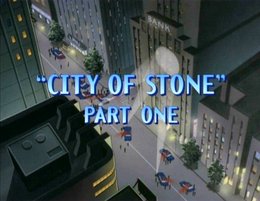City of Stone Part One
"City of Stone" Part One is the twenty-second televised episode of the series Gargoyles, and the ninth episode of Season 2. It originally aired on September 18, 1995.
- Story Editor: Michael Reaves
- Story: Michael Reaves
- Teleplay: Brynne Chandler Reaves & Lydia Marano
Contents
Summary
Continuity
Once again, a few familiar characters make cameos; Brendan and Margot are the bank robbers' hostages, and the two gargoyles whom Demona almost warns are Othello and Desdemona. There is also a glimpse of Princess Katharine, the Magus, and Tom loading up the eggs in their cart before leaving Castle Wyvern (as a foreshadowing of "Avalon Part One").
Demona describes Owen, after overpowering him, as "the tricky one". This is another subtle hint to his true identity as Puck, revealed in "The Gathering Part Two".
While Xanatos' desire for immortality won't officially enter the series until "The Price", his interest in Demona's offer of using stolen minutes from people's lives to expand his life-span is the first hint of that ambition.
Demona's earliest flashbacks crossover with the events of "Awakening Part One" and "Awakening Part Two". In particular, we learn more about the pact between Demona and the Captain of the Guard, mentioned in "Awakening Part Five", and we learn how Demona was able to survive the Wyvern Massacre.
Othello and Desdemona appear in Demona's flashback, prior to their deaths during the Wyvern Massacre. After the Massacre, she can be seen holding up the broken face of Othello, which in "Reawakening" was used to create Coldstone.
The Hunter appears for the first time.
Tidbits
"City of Stone" was originally intended to be a direct-to-video release, but the idea was rejected by Gary Krisel because Goliath and his clan did not have a large enough role in it. Fortunately, the story idea was turned into a Season Two multi-parter rather than abandoned altogether; Gargoyles would have been much poorer without it.
Macbeth's backstory in "City of Stone" differs strongly from the familiar plotline of William Shakespeare's Macbeth, of course, making Macbeth the hero and Duncan the villain. Instead, it bases itself on the Macbeth of real history, whose life-story was heavily distorted by Shakespeare (due to the fact that Shakespeare's own sources had already distorted the story). Also, Shakespeare was writing the play during the reign of James I, who was a descendant of Duncan and Malcolm Canmore - and also believed himself to be a descendant of the fictional Banquo and Fleance - thus making it anything but prudent to tell the actual story. Shakespeare may have also deliberately altered the story to produce a nightmarish atmosphere, chronicling its title character's descent into crime and bloodshed). John Rhys-Davies, who provided the voice of Macbeth in Gargoyles, was initially astonished at this alteration of the familiar play and even accused Greg Weisman of revisionism, but changed his mind when learning that it was based on the actual history of 11th century Scotland and then became very enthusiastic about it.
The Weird Sisters are, of course, the Gargoyles take on the Three Witches, but interpreted as being much more powerful than mere witches. While critical opinion is divided as to whether Shakespeare meant the Witches of his play to be mere human crones practicing black magic, or the goddesses of destiny (which was what his source, Raphael Holinshed, interpreted them as being), Greg definitely saw them as the latter. In fact, he made them into a blend of three different mythical triplets: the Fates, the Furies, and the Graces. Furthermore, each one of the Weird Sisters focuses on a different one of these trios: silver-haired Luna represents Fate, golden-haired Phoebe Grace, and raven-haired Seline Vengeance. The shift in their characterization throughout the series is described by him as due to the shift in which Sister's influence is uppermost at the time.
The individual names of the Weird Sisters, incidentally, are all taken from moon-goddesses in classical mythology. Luna was the Roman goddess of the moon, Phoebe a Titaness (the mother of Leto and grandmother of Apollo and Artemis) who was often associated with the moon - particularly in Elizabethan poetry such as Shakespeare's plays, and Selene the Greek goddess of the moon (Artemis took on that role only very late in the development of Greek myth) - and, incidentally, the sister of Helios, who would have a namesake character in "The New Olympians". We do not know as yet, however, exactly what link the Weird Sisters have to the moon, if any.
The Weird Sisters' three different ages (little girls, young women, ancient hags) are based on the concept in modern-day mythological studies of the feminine trinity of Maiden, Mother, and Crone.
Greg had plans to bring back the bank robbers in the spin-off Bad Guys, presumably as adversaries for the Redemption Squad.
Just before Demona breaks in on her signal, Elisa is watching the classic movie Casablanca on television.
Oddly enough, the petrified Elisa at the end of Part One is facing away from the gargoyles.
Toon Disney modified Goliath's conversation with the Weird Sisters ("I will never be like this terrorist." "We were not talking about this terrorist.") after the September 11 attacks, removing the word "terrorist" from the dialogue.
Links
| << Previous Episode: "Vows" | Next Episode: "City of Stone" Part Two >> |
